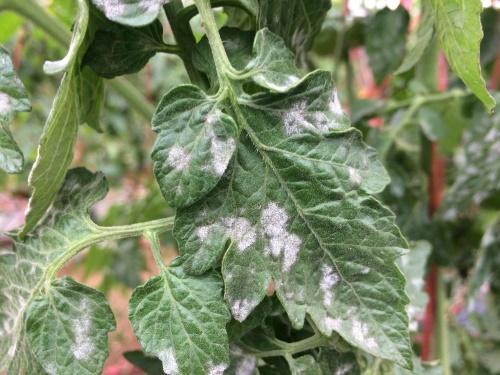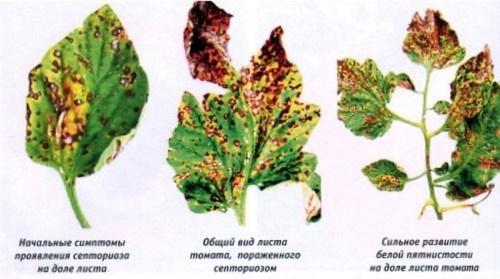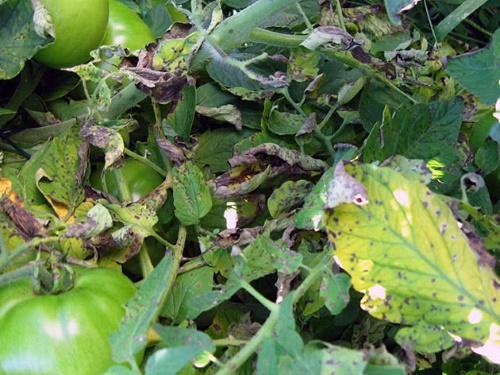Tomato septoriosis: signs of the disease, treatment and prevention measures
 Tomato septoria is one of the most dangerous diseases. It is able not only to pretty much spoil the bushes and slow down their development, but also to completely destroy the tomatoes. However, this is not all: the wind and insects quickly spread the spores throughout the site. If the onset of the disease is missed, almost all plantings are at risk. Horticultural crops, grapes and even indoor plants standing in the summertime on the street - they are all defenseless against the fungus. What is tomato septoria, how can it be treated, and can the appearance be prevented?
Tomato septoria is one of the most dangerous diseases. It is able not only to pretty much spoil the bushes and slow down their development, but also to completely destroy the tomatoes. However, this is not all: the wind and insects quickly spread the spores throughout the site. If the onset of the disease is missed, almost all plantings are at risk. Horticultural crops, grapes and even indoor plants standing in the summertime on the street - they are all defenseless against the fungus. What is tomato septoria, how can it be treated, and can the appearance be prevented?
How to recognize septoria - the main signs of tomato disease

 It is not difficult to make a mistake with the diagnosis. The following signs indicate the presence of septoria on tomato bushes:
It is not difficult to make a mistake with the diagnosis. The following signs indicate the presence of septoria on tomato bushes:
- small whitish spots appear on the lower leaves;
- in a couple of weeks, they increase in diameter up to 5 centimeters or more;
- at large spots the center and edging turn black;
- spotting extends to other parts of the plant - petioles, stems and fruits and can have both round and oval shapes;
- over time, the spots grow more and more and merge;
- leaves fall;
- the development of plants slows down and they wither.
Due to the fact that in the initial stage of septoria the spots are white, the disease is also called white spot.
Septoria tomato disease - ways to prevent and treat a dangerous disease
 Experienced gardeners know that it is easier to prevent septoria disease than to treat tomatoes later. The difficulty lies not only in the resistance of the fungus. They will quickly spread throughout the site. Therefore, you should carefully examine the beds so as not to miss the onset of the disease. For prevention, you need to pull out and remove weeds in a timely manner, plow a vegetable garden for the winter. When planting seedlings, leave enough space between the bushes and apply top dressing on time. Weakened and frail tomatoes are more vulnerable to fungal diseases. Greenhouses, on the other hand, should be disinfected every year and often ventilated. In addition, for cultivation, it is better to choose varieties with increased resistance to septoria. Among them - Horeb, Ballad, Golden Fleece, Worthy.
Experienced gardeners know that it is easier to prevent septoria disease than to treat tomatoes later. The difficulty lies not only in the resistance of the fungus. They will quickly spread throughout the site. Therefore, you should carefully examine the beds so as not to miss the onset of the disease. For prevention, you need to pull out and remove weeds in a timely manner, plow a vegetable garden for the winter. When planting seedlings, leave enough space between the bushes and apply top dressing on time. Weakened and frail tomatoes are more vulnerable to fungal diseases. Greenhouses, on the other hand, should be disinfected every year and often ventilated. In addition, for cultivation, it is better to choose varieties with increased resistance to septoria. Among them - Horeb, Ballad, Golden Fleece, Worthy.
Most of all, the Septoria fungus loves the pear and actively reproduces with its help. For this reason, you need to choose an area away from the tree for growing tomatoes.
If septoria has already managed to attack the tomato beds, it is urgent to start treatment. At the initial stage, there is a chance to save the bushes. But for this you need to tear off all the leaves with spots without pity. Then spray the plants. Spill the soil with copper sulfate or fungicide.Such drugs as Fundazol, Skor, Previkur work well. It is advisable to process the entire area. This will exclude the manifestation of septoria on other crops.